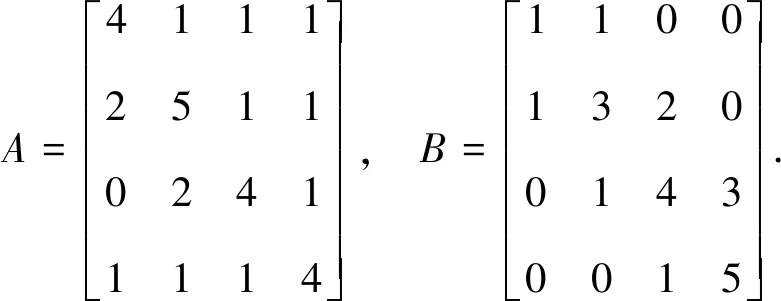New Upper Bounds for the Spectral Radius of Nonnegative Matrices
Chen Fubin
(Science Department, Oxbridge College, Kunming University of Science and Technology, Kunming 650106, China)
Abstract In this paper some new upper bounds to the spectral radius of the Hadamard product of two nonnegative matrices are studied by using Brauer’s theorem and Gerschgorin’s theorem. The Numerical example shows that the new results improve some existing results in some cases.
Key words Nonnegative matrix Hadamard product Spectral radius Upper bound
1 Introduction
For a positive integern, letNdenote the set {1,2,…,n}, Rn×ndenote the set of alln×nreal matrices and Cn×ndenote the set of alln×ncomplex matrices.
LetA=(aij)∈Cn×nandB=(bij)∈Cn×n. We writeA≥B(>B) ifaij≥bij(>bij) for alli,j∈{1,2,…,n}. If 0 is the null matrix andA≥0(>0), we say thatAis a nonnegative (positive) matrix. The spectral radius ofAis denoted byρ(A). IfAis a nonnegative matrix, the Perron-Frobenius theorem guarantees thatρ(A) is an eigenvalue ofA.
Ann×nmatrixAis reducible if there exists a permutation matrixPsuch that
whereB,Dare square matrices of order at least one. IfAis not reducible, then it is called irreducible. Note that any 1×1 matrix is irreducible[1].
For two real matricesA=(aij) andB=(bij) of the same size, the Hadamard product ofAandBisA∘B=(aijbij).
In [2-7], the following bounds forρ(A∘B) are given forA,B≥0 respectively:
ρ(A∘B)≤ρ(A)ρ(B),
(1.1)
(1.2)
(1.3)
(1.4)
(1.5)
(1.6)
Recently, Guo[8] gave two sharper upper bounds forρ(A∘B), that is
(1.7)
(1.8)
We will give two new upper bounds onρ(A∘B) for two nonnegative matricesAandB. Example is given to illustrate our results.
For a nonnegative matrixA=(aij) we shall use the following notations. Fori,j,k∈N, let
2 Some lemmas and main result
In order to prove our results, we need the following lemmas.
Lemma 2.1[9] LetA=(aij)∈Cn×n. Then all the eigenvalues ofAlie in the region:
Lemma 2.2[10] LetA=(aij)∈Cn×n. Then all the eigenvalues ofAlie in the region:
Theorem 2.1LetA,B∈Rn×n,A≥0 andB≥0. Then
(2.1)
ProofForn=1, it is evident that (2.1) holds. In the following, we assume thatn≥2.
Case 1: Suppose thatA∘Bis irreducible, obviouslyAandBare irreducible. By Lemma 2.1, there existsi(1≤i≤n) such that
i.e.,
thus, we have that
Case 2: Now, assume thatA∘Bis reducible. If we denote byD=(dij) then×npermutation matrix withd12=d23=…=dn-1,n=dn1=1, the remainingdijzero, then bothA+tDandB+tDare nonsingular irreducible matrices for any chosen positive real numbert. Now we substituteA+tDandB+tDforAandB, respectively in the previous case, and then lettingt→0, the result follows by continuity.
Theorem 2.2LetA,B∈Rn×n,A≥0 andB≥0. Then
(2.2)
ProofIt is evident that (2.2) is an equality forn=1. We now assume thatn≥2.
Case 1: Suppose thatA∘Bis irreducible. ObviouslyAandBare irreducible. Letλbe an eigenvalue ofA∘Band satisfyρ(A∘B)=λ. By Lemma 2.2, there is a pair (i,j) of positive integers withi≠jsuch that
Thus, we have
That is
Case 2: Now, assume thatA∘Bis reducible. If we denote byD=(dij) then×npermutation matrix withd12=d23=…=dn-1,n=dn1=1, the remainingdijzero, then bothA+tDandB+tDare nonsingular irreducible matrices for any chosen positive real numbert. Now we substituteA+tDandB+tDforAandB, respectively in the previous case, and then letting, the result follows by continuity.
RemarkNext, we give a comparison between inequality (2.1) and inequality (2.2). Without loss of generality, fori≠j, we assume that
(2.3)
Thus, (2.3) is equivalent to
(2.4)
From (2.2) and (2.4), we have
Thus, we have
So, the result of Theorem 2.2 is sharper than the result of Theorem 2.1.
3 Example
We consider the following two nonnegative matrices

By calculating with Matlab 7.0, we haveρ(A∘B)≤50.1274 (by (1.1)),ρ(A∘B)≤31.4611 (by (1.2)),ρ(A∘B)≤25.5364 (by (1.3)),ρ(A∘B)≤23.2 (by (1.4)),ρ(A∘B)≤25.3644 (by (1.5)),ρ(A∘B)≤28.446 (by (1.6)),ρ(A∘B)≤24 (by (1.7)),ρ(A∘B)≤22.1633 (by (1.8)). By Theorem 2.1, we haveρ(A∘B)≤23, By Theorem 2.2, we haveρ(A∘B)≤21.8816. In factρ(A∘B)=20.7439.
The example shows that the bound of Theorem 2.1 and 2.2 are less than the others.

